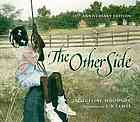Woodson, J., & Lewis, E. B. (2001). The other side. New York: Putnam's.
32 Pages
Ages 4-8
Plot:
This story begins with an unnamed young black girl noting that she sees a young white girl her age across the fence from her everyday but has been told she is not to cross this fence and play with this girl. The other girl has likewise been told a similar thing by her mother. But neither girl understand why and only want to play with their neighbor. Soon the girls decided that they were never told that they could not sit on the fence and talk, only that they were not to climb over. So the girls soon become friends, sharing this fence as well as their childhood interests. Soon the white girl is embraced by all the friends of the black girl and they all finish the story by agreeing that when they're older and able to make adult decisions they'll tear down such fences.
My Impressions:
This book provided a very straightforward account of racial divisons in mid century southern america from the perspective of children. From this point of view especially, such distinctions and seperations based on racial differences are clearly seen as unnatural. The story of the friendship between these two girls shows that skin color does not affect who you are as a person and the fact that two young children understand this while their parents do not only enhances the power of the message. I really liked how the book concluded with all the children acknowledging the foolishness of such a fence and such less literal divisions.
Reviews:
From Scholastic Parent & Child
"For Ages 5-8. Told by their mamas to stay on their own sides of the fence that divides their racially segregated town, two little girls (one black and one white) find a way to straddle the barrier and become friends. Glorious watercolors capture the long summer days. It's a slice of recent American history made accessible to young children."
Rovenger, J. (2001). The Other Side (Book). Scholastic Parent & Child, 9(1), 18.
From Library Talk
"Written from the point of view of a black child, this book employs the powerful symbol of a fence to emphasize the racial division in a southern town. Clover is torn between her family's notion of the "way it has always been" and her own feelings about her new white friend Annie. Though she has been told not to climb over the fence that divides the properties, Clover approaches the fence where Annie sits. Annie invites her to come and sit with her. As the summer ends, Annie and the black children begin to play together and to sit side by side on the fence. They speak of "Someday," when someone will knock down the old fence. This book delivers a subtle but powerful message about friendship and racial divisions in an earlier time in America. The hopeful "Someday" at the end of the book leads the reader to consider whether that someday has yet come. Wonderfully expressive watercolor paintings executed in soft pastels and restful greens appeal to the reader; they also help to communicate the feelings of the characters and the simple lifestyle in the small rural town. This is a lovely picture book for all ages. Highly Recommended."
Feehrer, B. B. (2001). The Other Side (Book Review). Library Talk, 14(4), 48.
Library Suggestions:
I think this book would be a great read-aloud story time book, especially in a classroom setting where issues of racial differences are being discussed. This book would be a great storytime book both because of its narrative as well as its illustrations. The engaging story is greatly enhanced by the beautiful illustrations which were by far my favorite part of the book.

No comments:
Post a Comment